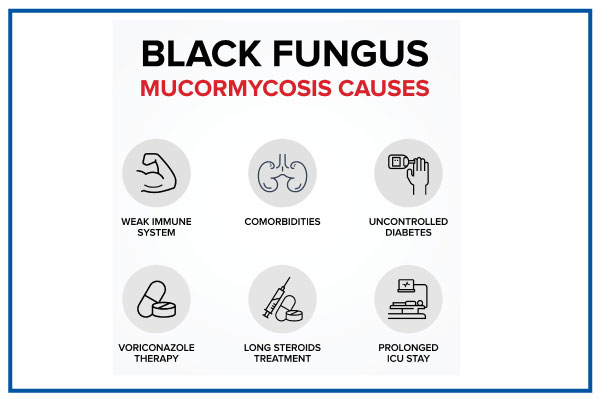- 3124
- 3.2 Minute
What is Black fungus infection (Mucormycosis)?
Black fungus, also known as Mucormycosis, is a rare but dangerous infection. Black fungus is caused by getting into contact with fungus spores in the environment. It can also form in the skin after the fungus enters through a cut, scrape, burn, or another type of skin trauma.
Fungi live in the environment, particularly in soil and decaying organic matter such as leaves, compost piles, rotten wood, and so on. This fungal infection is caused by a type of mould known as 'mucromycetes’. It should be noted that this rare fungal infection affects persons who have health issues or who use drugs that weaken the body's ability to fight the infections.

Black Fungus Causes
Mucormycetes are a type of mould that causes fungal infections. These moulds can be found everywhere in the environment, including soil, air, and food. They enter the body via the nose, mouth, or eyes and can have an impact on the brain if it is not treated on time. According to medical experts, the main cause of black fungus (mucormycosis) is steroid misuse during COVID treatment.
Black fungus (mucormycosis) primarily affects people who have health problems or who take medications that reduce the body's ability to fight germs and illness. The person's immunity is low after covid treatment, which makes them vulnerable to black fungus infection. People with diabetes and COVID-19 patients are at greater risk of developing an infection.
Black Fungus Symptoms
The symptoms of black fungus will vary depending on where the fungus is growing in your body. They may include the following:
- Fever
- Cough
- Chest pain
- Shortness of breath
- Swelling on one side of your face
- Headache
- Sinus congestion
- Black lesions on the top of the nose or the inside of the mouth
- Belly pain
- Nausea and vomiting
- Gastrointestinal bleeding
- Blood in your stool
- Diarrhea
If your skin is infected, the affected area may appear blistered, red, or swollen. It may turn black, feel warm, or be painful. Through your blood, the infection can also spread to other parts of your body. This is referred to as disseminated black fungus (mucormycosis). When this occurs, the fungus can attack organs such as your spleen and heart. In severe cases, you may experience mental changes or fall into a coma. It can even be fatal.
Secure your health with a second opinion. Make informed decisions and book your appointment today!
Get A Second OpinionBlack Fungus Risks
People who fall into the following categories are more likely to develop black fungus:
- Uncontrolled diabetes, diabetic ketoacidosis, and diabetics taking steroids or tocilizumab.
- Patients taking immunosuppressants or receiving anticancer treatment, as well as those suffering from a chronic debilitating illness
- Patients taking high doses of steroids or tocilizumab for an extended period
- Cases of COVID-19 Severity
- Patients on oxygen who required nasal prongs, a mask, or a ventilatory support
Patients who get COVID treatment within six weeks are more likely to develop black fungus.
Does Black fungus affects only COVID patients?
How Black fungus effects COVID patients?
Mucormycosis is a rare but serious fungal infection. While the cases of this infection were relatively less, the Covid-19 outbreak has given a boost to the spread of this infection. It is commonly known as black fungus, the infection is now detected among Covid-19 patients across India. With a significant increase in fungal infection cases, the government has mandated that all states have to report suspected and confirmed cases of mucormycosis to the Integrated Disease Surveillance Programme (IDSP).
Now let’s take a look at what this infection is and why it is caused more frequently among Covid-19 patients. The infection is rare, but once a person is infected, the fungus manifests in the skin or can affect the brain or lungs, many cases of this infection have been reported in Covid-19 patients.
Why is it occurring in COVID-19 patients?
Mucormycosis can occur after COVID-19 infection, whether during the hospital stay or a few weeks after discharge.
The COVID-19 generates a sudden change in the interior environment of the host for the fungus, and the medical treatment administered unknowingly promotes fungal development. COVID-19 causes harm to the airway mucosa and blood vessels. It also causes a rise in serum iron, which is required for the fungus to grow. Broad-spectrum antibiotics not only kill potentially harmful bacteria but also beneficial commensals. Although antifungals such as Voriconazole prevent Aspergillosis, Mucor survives and grows due to a lack of resistance. Long-term ventilation decreases immunity, and there is conjecture that the humidifier water that is delivered along with the oxygen transfers the fungus.
How Black fungus affects non-covid people?
Mucormycosis is a fungal infection that primarily affects patients with compromised immune systems, but it can also affect non-covid people. Experts warn if left untreated, this can become dangerous.
Black Fungus Treatment
- Mucormycosis treatment must be fast and aggressive. The concern is due to the fact that by the time even a presumptive diagnosis is made, the patient has often suffered significant tissue damage which cannot be reversed.
- Most patients will need surgical and medical treatment.
- Most infectious disease experts say that without aggressive surgical debridement of the infected area, the patient is likely to die.
- Medicines play an important role. Two main aims are sought simultaneously: antifungal drugs to slow or stop the fungal spread and drugs to treat debilitating underlying diseases.
- Amphotericin B (initially intravenous) is the usual drug of choice for antifungal therapy.
- Posaconazole or isavuconazole can treat mucormycosis.
- Patients may even require an intravenous antifungal procedure lasting 4 -6 weeks.
- Patients with underlying diseases like diabetes need to be in optimal control of their diabetes.
- Patients normally on steroids or taking deferoxamine (Desferal; used to remove excess iron from the body) are likely to have these drugs stopped because they can increase the survival of fungi in the body.
- Patients may need additional surgeries and usually need antifungal treatment for an extended period (weeks to months) depending on the severity of the disease.
Black Fungus Preventions
Preventive measures to be followed:
- Humidifier cleaning and replacement (for those using Oxygen Concentrators)
- The humidifier bottle should be sterilized with normal saline and refilled on a regular basis.
- Masks should be disinfected regularly, and they should not be used for weeks.
- Those who use steroids should also monitor their blood sugar levels.
- During the COVID-19 therapy, mortified oxygen should be utilized
- Practicing good hygiene and maintaining the cleanliness of their surroundings
- Brushing and gargling daily is extremely beneficial.
- If you have recovered from COVID, it is critical to wear masks to prevent the infection from entering the body.
- Diabetics patients must keep their diabetes under control and monitor their blood glucose levels
- These must be monitored, especially after infection with Covid-19. Steroid use is to be reduced, and immunomodulating drugs are to be discontinued
Do's and Don’ts to reduce the risk of Black fungus infection (mucormycosis)
| Do not ignore warning signs and symptoms | |
| Don’t consider that all cases of the blocked nose are caused by bacterial sinusitis, particularly in immunocompromised patients or COVID-19 patients on immunomodulators. | |
| For detecting fungal etiology, do not be afraid to conduct aggressive investigations (KOH staining and microscopy, culture, MALDI-TOF) | |
| Do not spend much time before starting treatment for mucormycosis. | |
Be aware of this, even after covid, don't take it easy. If you're diabetic, keep your sugar under control, if you have any of the symptoms mentioned, Get Yourself Tested the doctor can write CTPNS or MRI of PNS, this can be detected early, and treatment can be effective
Secure your health with a second opinion. Make informed decisions and book your appointment today!
Book an AppointmentFrequently Asked Questions
Mucormycosis is a fungal infection caused by the mucormycetes group of fungi. It is abundant in natural environments, particularly soil.
Black fungus (mucormycosis) is a complication caused by a fungal infection. People catch mucormycosis by coming in contact with the fungal spores in the environment. It can also occur in the skin once the fungus enters through a cut, scrape, burn, or another sort of skin damage.
Amphotericin-B is an antifungal medication used to treat a rare infection known as black fungus (mucormycosis). Five more pharmaceutical companies have received new drug approval for the production of Amphotericin-B within three days, according to a statement from the Ministry of Chemicals and Fertilizers.
Mucormycosis is a potentially fatal condition that causes blurred or double vision, chest pain, and breathing difficulties. It is most common in COVID-19 patients.
Covid-19 patients, patients with uncontrolled diabetic Mellitus (DM), Type 2 DM patients on high steroid therapy, patients receiving Immunosuppressive therapy, and patients in ICU for a long time, on oxygen therapy and with high ferritin are all high-risk categories for black fungus.
Mucormycosis is caused by a kind of mould known as a mucormycete. It may be present in the air, water, and even food. It enters the body by fungus spores in the air or can arise on the skin following a cut, burn, or skin damage
The rise in black fungus infections has been linked to an overuse of steroids in the treatment of coronavirus, which can severely weaken the immune system if used for a long time.
The medication needed to cure the virus could not be obtained from a medical shop since it could not be treated at home.
Local infections can occur if the fungus enters the body through a wound or burn. However, if it enters the body through the sinus, it can impact the eyes and, eventually, the brain, resulting in a deadly condition.
These illnesses are extremely dangerous, and most people will die if they are remaining untreated. The death rate ranges from 25% to 90%. Once the infection has gone to the brain, the fatality rate is quite high. As a result, early diagnosis and fast treatment are given a high priority.

